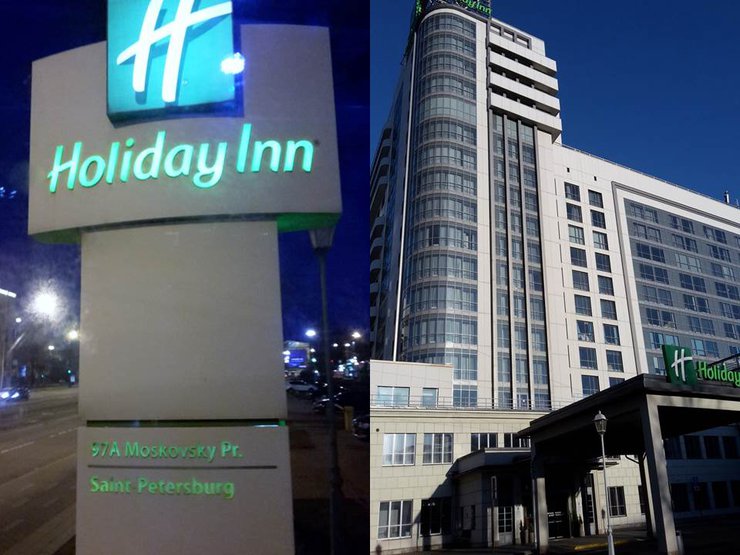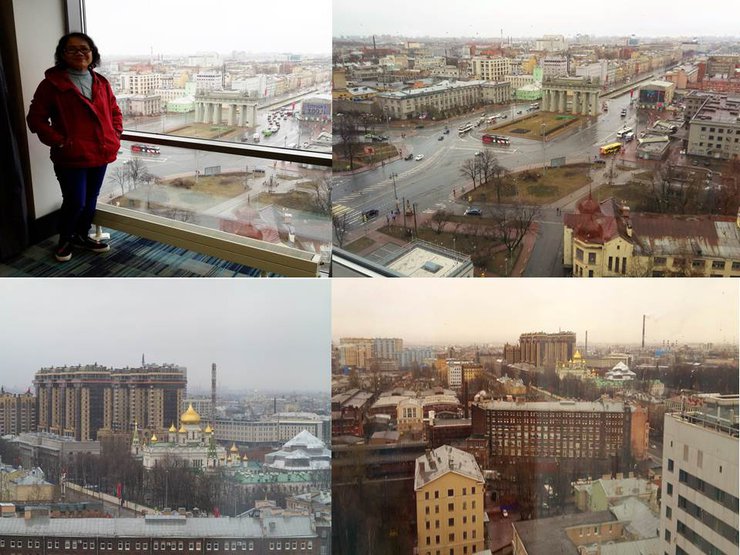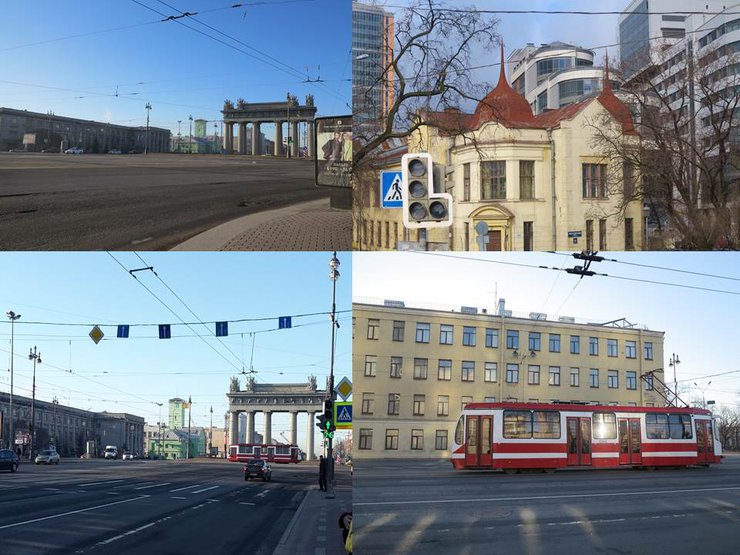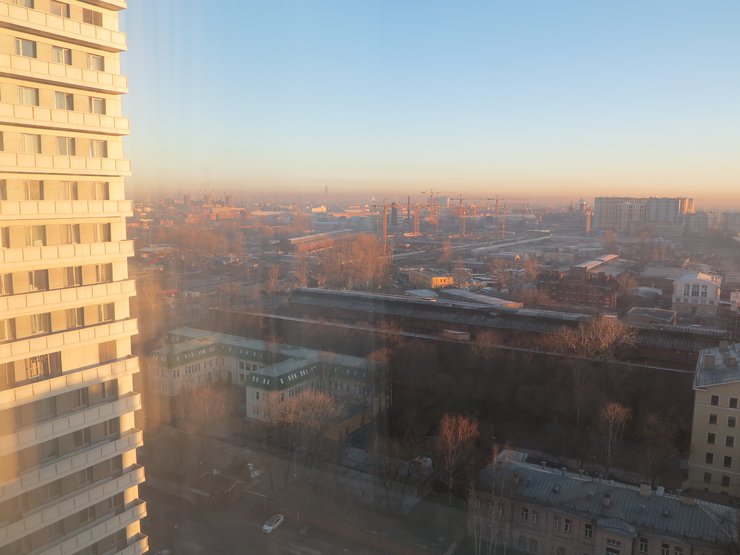Chapter 2: The Trip Begins
Continuing from the previous episode, we left Pulkovo Airport in St. Petersburg by bus and entered the city center, a distance of approximately 14 kilometers. At that time, it was around 9:30 PM (in Thailand, it would be around midnight, as Russia is 4 hours behind Thailand). We stayed at the Holiday Inn.
Accommodation

The temperature during our trip will range from 3 to 15 degrees Celsius. The weather will be a mix of rain, overcast skies, and some sunshine, with clouds as well. The photos may not be as bright as usual. For preparing for the cold, a moderate level of protection should be sufficient.
Photographs taken from the 17th floor of the hotel and from the guest rooms.

A photograph of the front of the hotel at around 7 am. The street is still empty because Russians usually start work around 9 am. You can see that trams and cars can share the road. The atmosphere on the first day was overcast and rainy, while on the second day there was some sunshine.

Inside the room

Translated from Thai to English:
Photographed from the hotel room at approximately six o'clock in the morning, 17th floor.




A view of the opposite side of the hotel in the early morning.

Across the street from the hotel, it was already past eight in the morning.




Inside the hotel restaurant



The front of the hotel


On the first day of our trip, we visited the Rostral Columns, a pair of red granite columns located on the Vasilievsky Island embankment of the Neva River. These columns, which once served as lighthouses for navigation, marked the starting point of our exploration. Although our time was limited, we managed to capture a glimpse of the area's vastness. The Rostral Columns stand as a testament to the historical significance of this maritime hub.

The design is in the style of ancient Rome, decorated with a green ship's bow around the columns. There are two stone carvings of gods (one of Neptune and the other unknown), which seem to symbolize the protection of the sea.



Gazing out across the vast expanse of the river, we see the towering spires of the Peter and Paul Fortress, our next destination, piercing the sky.

We stopped at a souvenir shop to use the restroom and take some pictures to share.



We departed from here, the car running alongside the riverbank, capturing images of the scenery along the way.





Houses along the way


Peter and Paul Fortress: A Historical Landmark in Saint Petersburg
The Peter and Paul Fortress, located on Vasilievsky Island, stands as a testament to the city's rich history. Built by Peter the Great in 1703, the fortress served as a tribute to Saints Peter and Paul and marked the founding of Saint Petersburg. Its construction, spanning four decades, reflects the Baroque architectural style prevalent during that era.
The fortress, reaching a height of 122.5 meters, boasts a hexagonal shape and sturdy brick walls, designed to withstand enemy attacks. Its historical significance and architectural grandeur make it a prominent landmark in Saint Petersburg.
Figure 1. Illustration (first image from the map).


The entrance features a large, arched doorway with blue doors.

The red building inside the gate is a building surrounded like a fence or wall.

The interior is a large courtyard paved with stones of various sizes. The complex consists of several buildings. According to information, the area surrounding the cathedral included a mint and a prison for political offenders. Tsarevich Alexei, the eldest son of Peter the Great, was also imprisoned here due to his disagreements with his father and died here. The Peter and Paul Cathedral is a yellow building with a high, pointed shape and a bell tower at the top. It is currently a historical museum with a sacred temple.











The Bell Tower's Interior
The interior of the towering bell tower is spacious and adorned with soft green, light blue, and reddish-pink hues. The walls are decorated with marble-like patterns, and the ceiling beneath the dome features intricate paintings and ornate, golden chandeliers. The exquisite craftsmanship and artistic details showcase the vision of the designers and the skill of the artisans of that era. (According to some sources, the style is Naryshkin Baroque.) The interior design follows the traditional concept of Russian churches, with elaborate wood carvings covered in thick, gleaming gold leaf. There are also Orthodox-style paintings on wood, including depictions of saints.
Currently, the bell tower serves as the burial place of Russian tsars. The remains of Peter the Great, along with several other members of the Romanov dynasty, including Tsar Nicholas II and his family who were tragically murdered, are interred here.








An exterior view of the fort after exiting the premises.


Access to the site is relatively relaxed (no need to remove shoes or jackets), and photography is permitted inside. We admired the beauty and artistry, and felt the grandeur of the location. Each person enjoyed different aspects based on their interests. After spending a considerable amount of time inside, we gradually returned outside. Reviewing the photos we took helped us understand why this place is a significant historical site in Russia.
From the map, it appears that this area is vast, encompassing the entire island. However, the portion accessible to tourists is only a small fraction of the total landmass.
The weather today is sunny and not too cold. Leaving here, the next stop is the Church of Christ's Resurrection. Along the way, I took pictures of the buildings and houses. The buildings are mostly rigid in style, but the colors soften the overall impression. Perhaps because the city is very cold, the architectural style has adapted to the local climate.



Cars were parked along the side of the temple, leaving only a small space. The driver skillfully maneuvered the large vehicle through the narrow gap to park.
Getting off the car in a daze, we had to cross the road and a bridge with a river or canal next to the temple. There were a moderate number of people, including Chinese, Japanese, and tourists. My friends were all looking for angles to take pictures of themselves. From the outside, the church or temple looked intricate and beautiful, with its carved patterns and architectural elements. It had a dome shaped like an onion, like something out of a Disney cartoon. It was a huge building, surrounded by other buildings and a garden. The road in front of it was quite busy and noisy.
The Church of the Savior on Spilled Blood was built by Tsar Alexander III to commemorate his father, Alexander II, who was assassinated on this site. The church's architecture is a revival of the 12th-century Muscovite style.
Photographs of the front area (photos from multiple cameras)












Admission requires a ticket, photography is permitted, and visitors must pass through a scanner or remove their jackets.








Every inch of the walls, under the sharp dome, and every pillar is inscribed or painted in gold, blue, or reddish-blue tones, and other colors. Although the stories depicted are not fully understood, they seem to be related to Christianity, God, and heaven. The intricate craftsmanship is said to have involved more than 30 artisans or painters. What we see today is not entirely original, as parts of it were damaged during World War II and subsequently restored. (The afternoon weather was not very bright.)
We departed from the location in the same vehicle. The sky began to darken, suggesting that we would likely encounter rain. The car drove in circles, giving the impression that each location was not far from the others. We saw the Alexander Column (a monument to Peter the Great), a wide square, and yellow buildings, but we did not stop.
Photo taken from inside the car.

We passed by the Kazan Cathedral, but we did not stop to visit it. The photos of the city were taken from inside the car.






Conclusion
The weather today is cold but sunny. The mornings are still quiet as most Russians start work around 9 am. This is because the country experiences late sunsets, with the sun not setting until 8 or 9 pm. Traffic congestion is similar to that in Thailand. The grandeur and beauty of the buildings are truly remarkable.
Stay tuned for the next episode.
enjoyinglife
Tuesday, October 8, 2024 10:28 AM
















